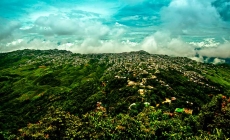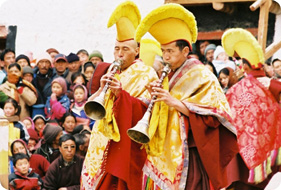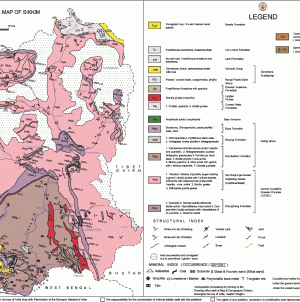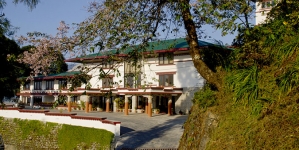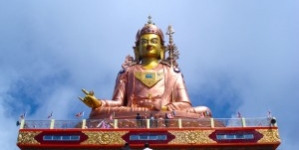-
Rajasthan - November 4, 2015
-
Haryana History - November 1, 2015
-
Haryana - November 1, 2015
-
Mizoram Minerals - March 3, 2015
-
Mizoram Hotels - March 2, 2015
-
Mizoram Culture - March 2, 2015
-
Mizoram Tourist Places - March 2, 2015
-
Mizoram History - March 1, 2015
-
Chhattisgarh Minerals - February 27, 2015
-
Chhattisgarh Hotels - February 27, 2015
West Sikkim has equally mixed communities living in different villages:
The Bhutias on of the indigenous tribe of Sikkim are found in the villages of Naku Chumbong, Singyang Sindrang, Yuksam, Tashiding, Melli, Nambu, Gayzing, Yangthang, kyongsa Tigjya and Lingchom. These villages in the distances of about 3kms to max. 35kms from Pelling. They look stout in figure mostly wearing long gown type costume called Kho or Namza (Bakhu in Nepali) and either felt hat or their traditional hat Shambu. They speak a dialect called Lhokay and they are proud Buddhist by faith. The Bhutias houses are comparatively bigger traditionally made of timber and stones with most having big prayers flags in front. They are farmers and cattle herders by professions. Their unique food is Tosha Gyari a set non veg rice meal served in brassware rice plate and their traditional drink is solchhyang Brewed millet beer served in bamboo decorated with silver strips. Their main celebrations are Lossong Naysol, Bumkor and marriages. Some of the well informed persons are Mr. Capt. Sonam Yongda of D.P.C.A. Mr. Tobden Lharipa of Singyang , Mr. D.N. Thakarpa the Hon’ble Speaker Yangthang. Yab Zantarey of Yang Tey and Yab Dorjee Lobon of Sindrang.
Lepchas the indigenous tribe of Sikkim are found in the villages of Sindrang , Singlitam, Khecheopalri, Lethang and Gangyap. These villages in the distances of 5kms to 30 kms from Pelling. They look fair in complexion, shy in nature wearing generally a kind of set wear of shirt and trousers called Hontaj Gyador . However their traditional costume is a sheet of traditional hand loom called Gada.They call themselves Rong in their language . They speak their own dialect and they too follow the same Tibetan form of Buddhism besides their local faith. Their Religious priest s are called Bong things. Their main festival is Tendong Lhorum faat. Some of their well informed persons are P.T. Lepcha of Darap, Mondol Kancha of Sindrang, Mr.Dawchho Lepcha the Hon’ble MLA and Mr. O.T.Bhutia member Rajya Sabha of Rinchenpong.
Gurung an indigenous tribe of Sikkim from Nepali stock are found in the villages of Khorong, Sardon, Singyang and Beghaa, about 5kms to 20kms from Pelling. They are shepherds and their woman weave a kind of traditional carpet called Rari and coat called Lukuni. They call themselves Tamu and their main celebration is their Tamu Lochar . They are Buddhist too. Mr. D.S.Gurung of Singyang, Mr. D.B. Gurung of Yangthang and Mr. Mohn Gurung of Yuksam a few well informed persons.
The Chettri and Bahun the indigenous community of Sikkim from Nepali stock are found in the Villages of Chumbung, Lower Gayzing and Sakyong, about 5ks to 15ks from Pelling. The Most look stout and tall wearing set of comfortable shirt and trousers mostly white in colour called Daura Suruwal with a proper coat on out side and a cap on head called Nepali topi and preferably leather shoes . The women wear Gunyu and Cholo preferably of Dhaka or Chhit . They speak Nepali. They are stout Hindu by faith their priests are spiritually learned Bahuns . Their festivals are Dasain , Tyohar, Teez, Ram Nawami and Sankrati and they worship cow as sacred animal. They are farmers and cattle herders by professions. Their unique food too is rice set meal with curd and milk and sometimes non veg. One or two storied mud houses with thatch roof having brick red and white coloured walls is their traditional Nepali houses. Some well informed persons are Mr. Sher Bahadur Subedi the Hon’ble Minister of Gayzing, Mr. Tek Nath Tewari, and Narayan Sharma of Langang / Lingchom.
Limboos are one of the indigenous tribe of Sikkim belonging to Nepali stock , Mongoloid looking by figure having their own language , faith, costume, culture and life style. They are mostly found in the villages of Darap, Nambu, Simpheng, Rimbi, Heegaon, Uttarey and some in Tigjek Lingchom. These villages are in the distances of 10 to 30 ks from Pelling. Their traditional group dance called Dhannach is famous usually performed in the marriage, death and any festive celebrations. Their traditional drum instrument is called Chyabrung.
They are farmers by profession and they love enjoying their life more by singing, feasting and dancing. Their religious priest is called Yeba or Fedanga. Their worshipping figure is the female goddess Yumasama.The place of worship is called Manghim, Their heroic figure that ever lived is Shri Junga. Some well informed persons are Mrs Kalawati Subba the hon’ble minister, Mr. Sanchaman Limboo The Ex C. M. of Pelling, Mr. H.B. Subba of Darap, Narendra Subba of Heegaon and Mr. Sher Bahadur Limboo of Uttarey.
Rai too are one of the indigenous tribe of Sikkim belonging to Nepali stock who too look mongoloid by feature and they are mostly found in the villages of Tathang, Melli and Bhaluthang, each in the distance of about 12ks from Pelling. They too have their own dialect ,local faith, culture and life style and their main festival is Sakewa and their popular cuisine is Wachipa. Some of their informed persons are Mr .B. B. Rai of Legship, Mr. K.D. Rai of Pelling , Mr. Man Bir Rai of Sakyong and A.B. Rai of Melli.
Tamangs are one of indigenous Nepali origin tribe of Sikkim having their own language , costume, culture and way of life. They follow Tibetan form of Buddhism having monasteries in their area. In Sikkim they are found quite scattered and available every where . Some Tamang families can be found in the village called Dokothang about 3ks from Pelling. They are by cast the lovers of dance and music Their traditional drum instrument is called Damphu. One main figure in their village is Mr. Kazi man Tamang.
Newaris are one of the indigenous Nepali origin tribes of Sikkim . They are historically recorded as the money minters of Sikkim the noted families of which are called Taxari and Vansari. They have their own language, script, costume , culture, traditions and way of life. They are either Hindu or Buddhist . Their traditional art, paintings and sculptures are famous in world . Their traditional Newari cuisines particularly the preparation of variety of pickles are their specialty and they are mostly businessmen except some farmers and other job holders. These Newaris are mostly found in Gayzing Tashiding, Legship, Pelling and other nearest towns. Some well informed persons belonging to their community are Mr. Durga Prashad Pradhan of Pelling, Mr. Tulshi Pradhan of Legship and Bishnu Pradhan of Gayzing.
Marwaris are the communities who are originally from the neighboring state of Haryana who began to live in Sikkim for the last many years and available in most markets s and town of Sikkim. Some of the Old Marwari families are found in Gayzing Bazar the nearest town of Pelling. They are Merchants by Profession and they are strict Hindus by faith and pure vegetarian . Some of their ancestors have been bankers in Sikkim the time when there was no Public Bank. One such family is Jethmull BhojRaj Who also had Bank Branch in Tibet too in the days way back. One influential living figure is Mr. Badri Prashad of Gayzing,
References:
http://www.gopelling.net/people_culture_traditions.html








